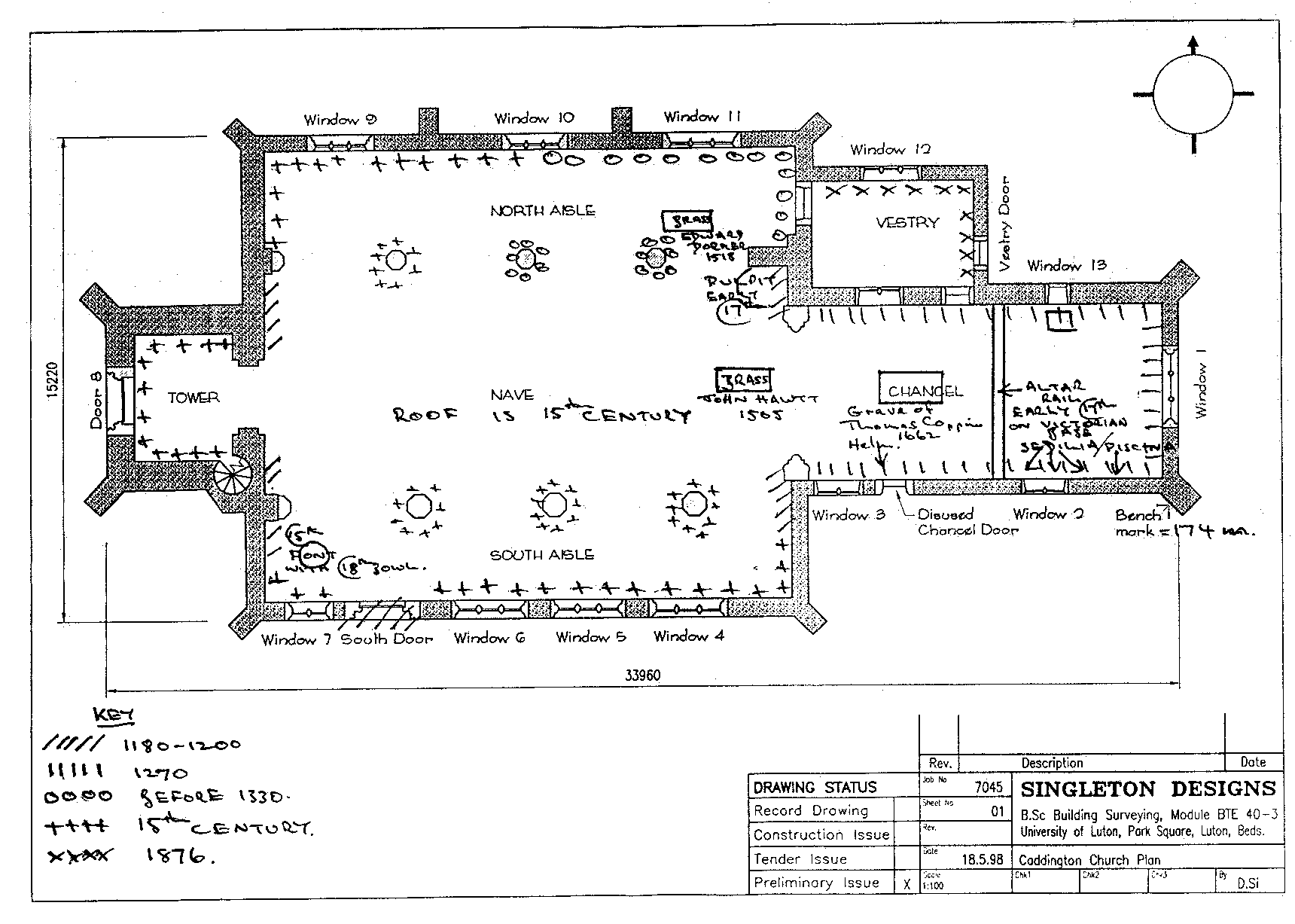
All Saints Church, Caddington
Historical Notes
Further notes are available as a download here.
How long has there been a church in Caddington?
We do not know. The Anglo-Saxons did not occupy the Chiltern area till the 3rd quarter of the 6th century, not long before St. Augustine brought the gospel from Rome. Settled life only began after this. In the 8th & 9th centuries Caddington was on the border between the warring English and Danes. Church buildings came into existence as a result of missionary work from minsters (monasteries). There were minsters in St. Albans and Bedford. Caddington is probably the ‘dune’ or ‘hill’ of an Anglo-Saxon local lord called ‘Cada’. At some time during this period a priest might have come to the hill (the church’s bench mark is 174 m. above sea-level), set up a cross and preached the faith. The local lord granted him a place to build both a house and a church – 2 simple rooms – possibly on the site of the present church. The church would have been built of daub and wattle. We know for sure that a church existed by the 10th century, before the Norman conquest.
How old is the present church?
Stone churches became more possible after the Conquest. The earliest visible parts of the church are the central part of the W. wall of the nave, the bases of the chancel arches, and the main S. door, which was later moved to its present position, but is clearly Romanesque in style. The original church was a single storey, aisleless nave, with a small chancel. In 1270 the chancel was enlarged, and the chancel arch replaced by an Early English arch, built on the earlier bases. The sanctuary contains a sedilia (stone seats for clergy) and a double piscina (bowls for washing the communion vessels). A 2-bay chapel was added on the N. side before 1330 (note the different capitals on these two pillars). In the 15th century this chapel was extended to make a complete N. aisle, a S. aisle was added, the Tower built, and the roof raised with a clerestory, Some of the pews under the organ also date from this century (most of the pews are Victorian). Throughout this period window improvements gradually made the interior lighter. The church was little changed after this. However a major restoration was carried out in 1876 (if all the large letters in the inscription on the S. wall of the nave are counted, as Roman numerals, they add up to 1876, and the date is also recorded on the heads of the external drainpipes). Pews were fitted at this time, and most of the external stonework dates from this restoration.
Interesting features:-
The font
This dates from the 15th century, and is decorated with symbols of life. The small bowl inside the font is from the 18th Century, and the inscription on the top reads (in Greek) ‘Nipson anomema, me monan ho psin’ -’Wash away iniquity, not just your face’. It is a Greek palindrome.
The brasses
The brass in the central aisle of the nave is that of John Hawtt (1505). The one in the N. aisle is that of Edward Dormer (1518), with his 2 wives.
The funerary helm
This is a 16th century item, and was probably brought back to England after the Restoration of King Charles II in 1659. It was used at the funeral of Sir Thomas Coppin, of Markyate Cell in 1662 (Markyate was then in Caddington parish.)
The pulpit, the altar rail & the sanctuary chair
These items are all from the early 17th century. When William Laud became Archbishop of Canterbury in 1633, he tried to insist that the worship of the Church should be more dignified, in opposition to the Puritans, who favoured freedom and informality. Amongst other things he wanted altar rails (to keep animals out of the sanctuary), a proper chair for the priest, and a proper pulpit. It could be that these items date from this period.
The charity boards
In the 18th and early 19th centuries, there was no social security, and inequalities of wealth increased. Some rich people felt drawn to bequeath property to assist some of the poor. The Caddington Charities still exist, and at Christmas can offer £1 to poor Widows who attend divine service!
The clock
This one-handed clock has recently been restored, but is still in more or less original working order, dating from 1695.
The organ
dates from 1912.
